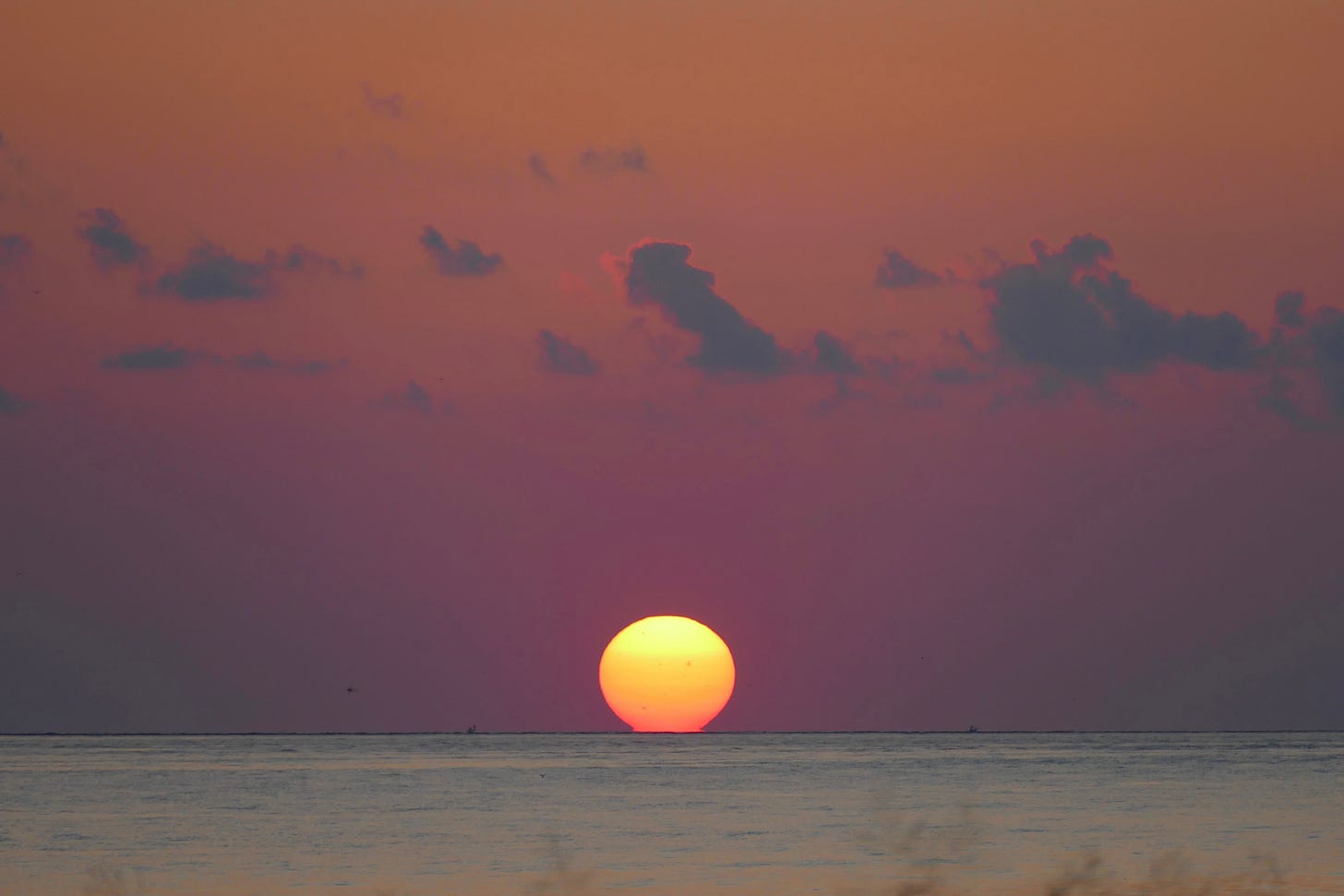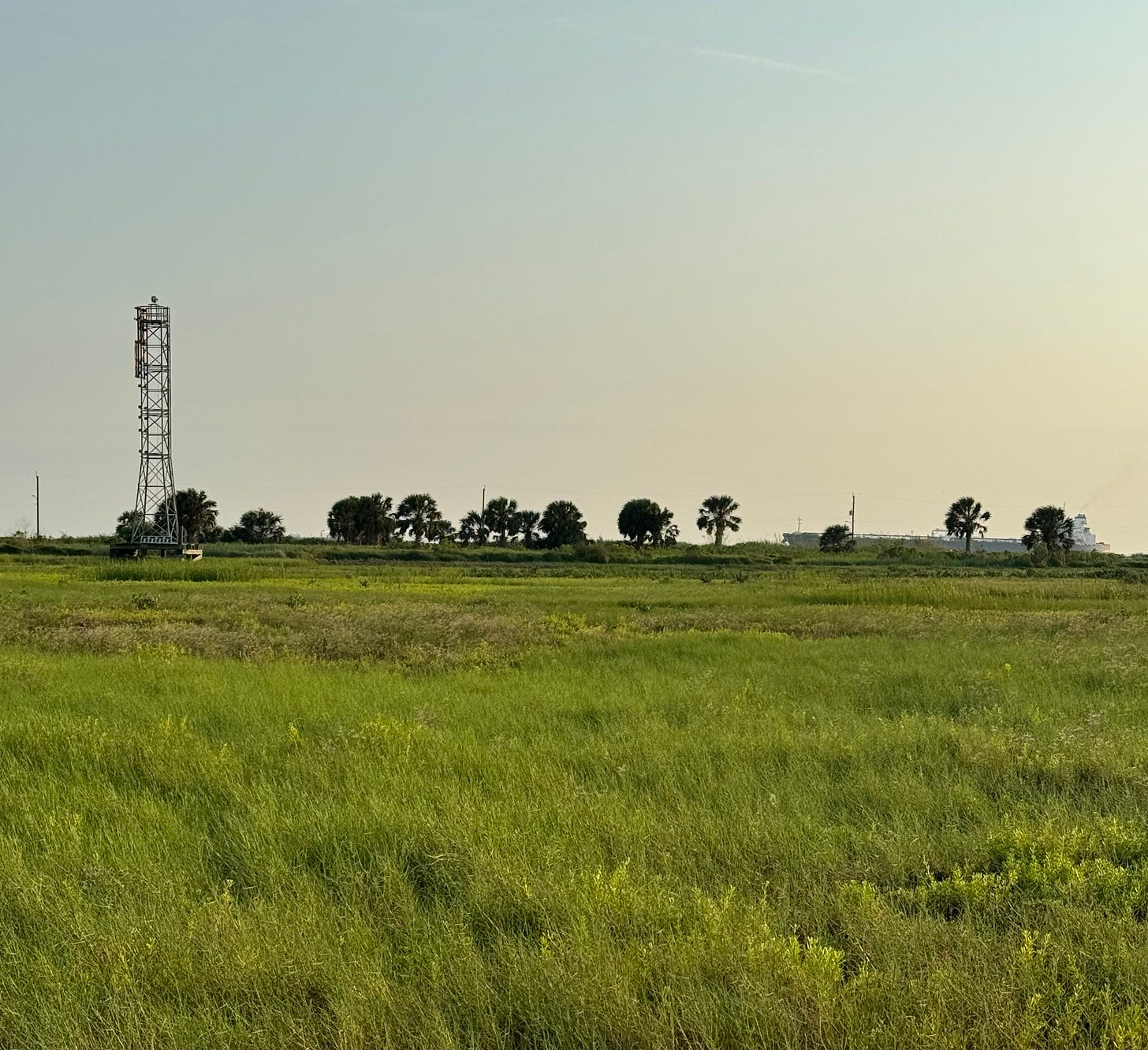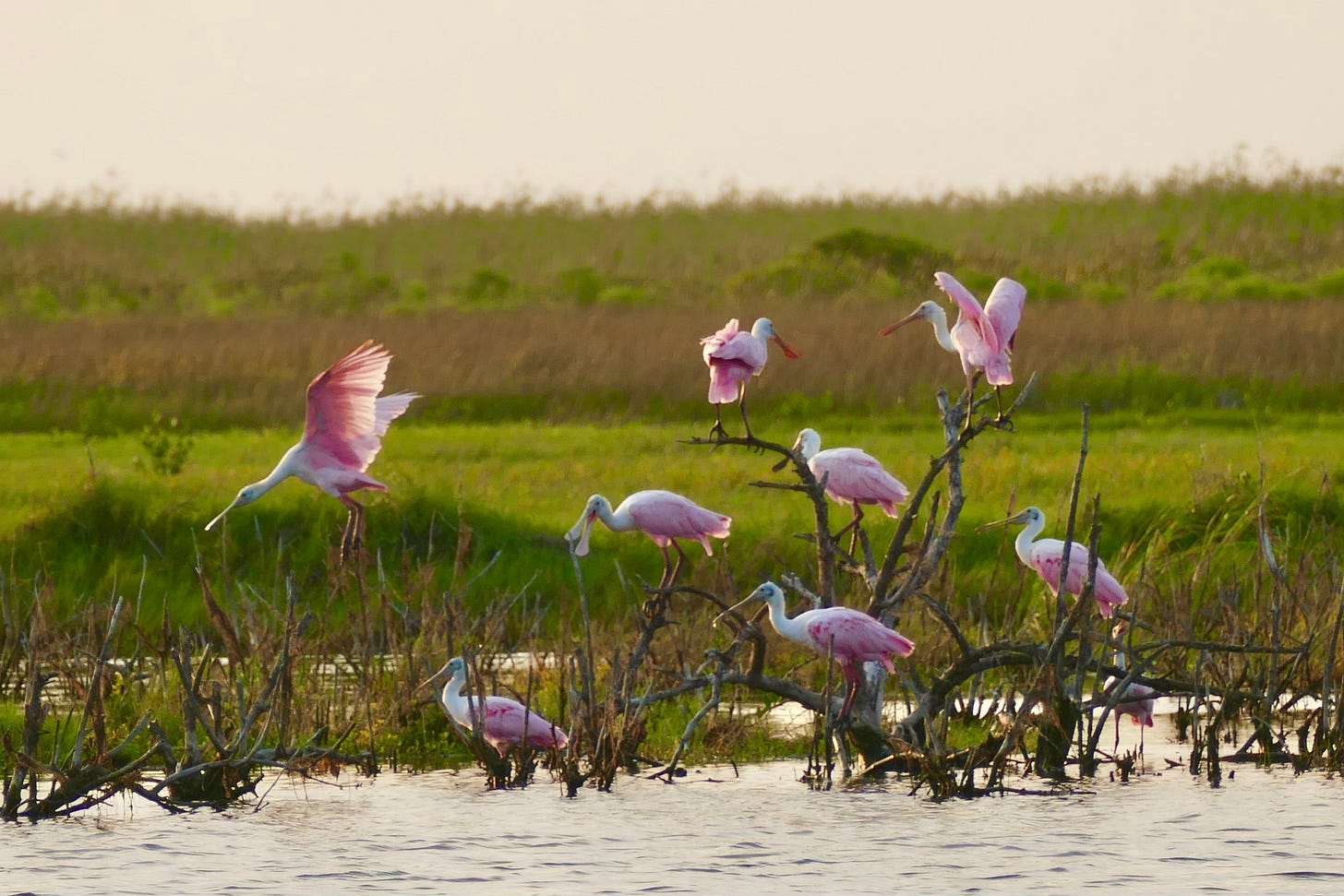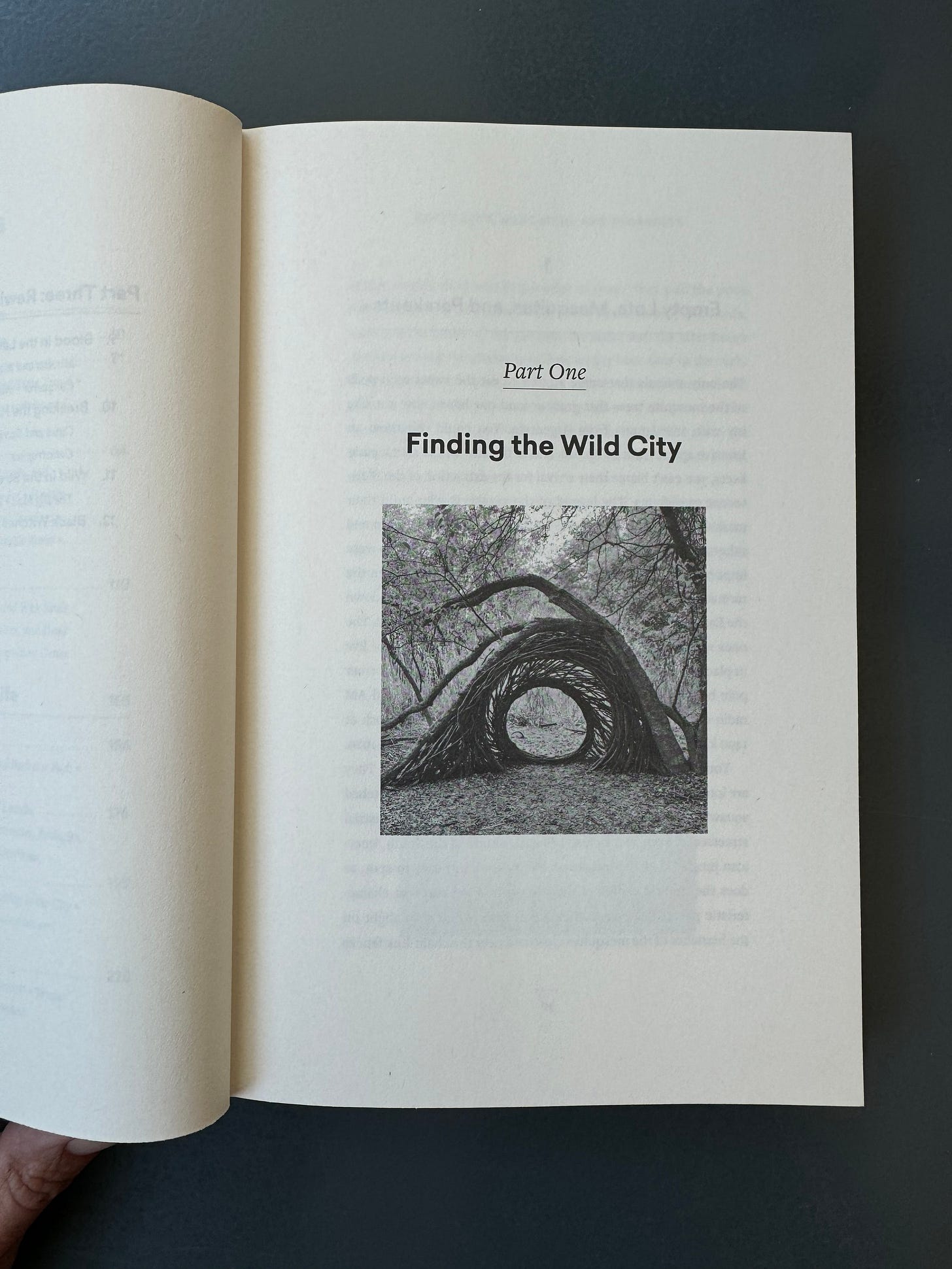The Great God Thoth is alive and well and living in Margaritaville
No. 159

When we got to Galveston, I had the idea I would sneak out in the early morning while my family slept in to see if I could see some of the ghost wolves. I had been reading about them for a couple of years since their 2022 profile in the NYT, and even wrote about them in my own new book about edgeland nature, fascinated by the idea of an animal long thought extinct in the wild—Texas’ native red wolf—discovered to have interbred with coyotes and now holding out as a charismatic specter in the empty lots behind some old apartment buildings where metro Houston dissolves into the Gulf of Mexico.
Texas Monthly ran a story in its most recent issue about how the ghost wolves have been adopted by the locals as their spirit animal, just as a massive development project—a new location for Jimmy Buffett’s Margaritaville resort—threatens to erase much of their current habitat. That gave me a rough idea, at least, of where to look, and the likelihood that conditions may not be the same in a year.
Galveston is a weird town. It should have been a major city in its own right, and it was in the 19th century, but the hurricane of 1900—the deadliest natural disaster in American history—ended that. Houston dredged its river into the Ship Channel, and after Spindletop exploded as the capital of the oil patch. Galveston settled for a new status as a Prohibition-era party town, complete with old-school mobsters, and more recently, in the cool old downtown and grand pre-war residential blocks behind the seawall, a weird little outgrowth of the coolest parts of Houston, like Montrose-on-the-beach.
More than anything, to me it has the vibe of a post-climate change city. A place where the possibility of capital was checked by nature, and what survived was some smaller-scale compromise, with pockets of post-growth utopia to be found between stretches of crass beachfront consumerism and blocks of edge city poverty.
Despite 25 years living in Texas, I had never been to the island. Or only vicariously, through narratives of other Galvestons—Cabeza de Vaca’s journal of his 1528 shipwreck, years as a captive of the Karankawa, and eventual transformation into a wandering healer who walked across the entire continent; and Bruce Sterling’s prescient 1988 novel Islands in the Net, which imagines a future in which the place sometimes known as the “Free State of Galveston” more fully achieves its potential as temporary autonomous zone.
The sense of temporal distortion I brought with me was punctuated on our arrival at the Grand Galvez, a stately turn-of-the-century beachfront hotel now getting by as an alt-Marriott. The gallery near the lobby had been disguised as the Roaring Twenties, complete with a telegraph desk, old telephone booths, and a rack selling facsimile newspapers dated March 22, 1924. The week after we left, we learned, they would be shooting scenes for the new season of the Taylor Sheridan series 1923, which sounded like it may have been smoking some Legends of the Fall while watching Heaven’s Gate. We were vacationing on a movie set, but I was keen to see if I could find a rogue nature documentary beyond the backlot.
I was a casual tourist without a clue regarding the island’s geography, and the available news stories about the quasi-cryptids were imprecise regarding location. So I looked up the imminent address of Margaritaville, and saw it was right by the municipal dumpsters I had noticed behind the beach on my Friday afternoon run, at the junction where the seawall cuts inland and leaves a big stretch of open land. Just the kind of Anthropocene ecotone where the four-legged hunters and foragers would be likely to come out at night.
At the northeastern tip of the island, I saw a very tiny nature preserve marked on the map, which I figured would provide a safe place to park. I put on the about-to-be-retired pair of trail runners I had brought, after realizing I only had dress socks to wear under them, and headed that way Saturday morning at dawn.
The preserve was a little pocket park with accessible trails, at a spot on a sand-covered beach road along the waterway known as Bolivar Roads, where the big tankers line up to exit and enter the Ship Channel. The roads encircled an expansive coastal flat—really a giant lagoon of varying degrees of wetness. As I arrived I saw a few fishermen setting up, and the beacons of the marine leviathans floating slowly by. As soon as I got out of the car, I saw canine tracks in the sand, mixed with tire tracks, which seemed as likely to be from dogs. I followed the path as the light dialed up, beckoned by some kind of communications tower I could see in the near distance.
The path was just a little loop, and I looked for animal trails off of it and into the marsh. There were no signs denoting private property, or prohibitions on stepping off trail. The foliage around the edge of the preserve was extra thick, perhaps a deliberately cultivated deterrent to bushwhackers. I scanned the imaginary horizon line in every direction, as a Subaru salesman who was also an expert tracker once taught me as a good way to spot wildlife. And quickly, I saw movement in the distance—not the quicksilver of coyote, but a flash of something pink and feathery. A lot of it.
I found the trace of an animal trail, and followed it off the official path, into the sort of terrain where every step feels like you may plunge into a hole. There were beachfront high-rises in the distance, contrails in the sky, and the machine sounds of the city waking up layered behind the sounds of all the wild birds hidden in the thickets through which I was moving. I worked my way closer to the pink, staying dry until that first kerplunk. The water was warm, and smelled like the swamp when you lifted your foot out, a smell of organic matter decaying in brackish water under a hot sun.
The first time I ever saw roseate spoonbills, they were in one of the largest flocks of birds I have ever encountered, taking off in a giant pink cloud along a bend in a Costa Rican river. This group was smaller, maybe a dozen, but equally beautiful. And they let me get remarkably close, close enough to watch them fish and groom for a long while. Those crazy beaks and lush colors never bore.
As I scanned around, I saw signs of more spoonbills further back in the lagoon, along with what looked to be other species—stilts, egrets, and night herons—and determined to try to check that out. I was already wet, and it was a beautiful morning with the sun now full.
As I worked my way back there, I found more trailsign. Evidence of recent travelers moving through the tall grass. And when I followed that path, it led me along dry terrain.
Soon, I found coyote scat on the trail. And then started to see the tracks.
I followed some, and could see there had been a lot of recent coyote activity back in there. Groups out together, on the move and hanging out. Lots of obvious animal trails connecting the laguna with the developed area along the beach. But no animals visible anywhere along the line of view, even though there was minimal cover and an almost tabletop-flat topography. The serious trackers always say that most wild animals will take off around ten seconds before you arrive at their spot. And on open terrain like that marsh, you might have to crawl to be able to sneak up on anything.
Maybe they were all hunkered down in their dens for the hot day ahead. Or maybe they were all around, watching me from cover I lacked the skills to see. It was time for me to rejoin my own family, so I walked a little further to check out the second spoonbill roost, then headed back.
Later that afternoon, in the gift shop looking for a sun hat for our daughter before she and I went to the amusement pier, I got to talking with the manager, a woman close to my own age. First we started talking about the ghosts in the hotel, which I had read about in the hotel history book, noting that the most haunted of the rooms was the one next to ours. She revealed she is the guide who leads the local ghost tours, and advised me our room was haunted, too. I asked her if she knew where I could find the ghost wolves, and after expressing her sadness at what’s coming for them, she said the place they like to hang out is just west of where I had been—in the ruins of the old gun emplacements.
Awakened before five by a ghost guide-induced dream of a wolf pack awaiting me in the beachfront ruins, I headed out even earlier Sunday. I thought I would improve my odds by finding a sit spot in the dark and waiting to see if any animals might appear as dawn arrived. This time I parked where the pavement ended at the shore, and set out along the beach. Stymied by an inlet too deep to cross, I cut back along an old jeep road a hundred yards or so inland, and tracked back in there that way.
There were more weird old comms towers back in there, amping up the Tarkovsky vibe, and lush wildflowers along the path. But it was also thick with mosquitoes, so intense that I had to cover my face with my bandanna, and take off my glasses so I could swat them from the one uncovered area around my eyes. I walked the half-mile to the beach, and saw the breakers lapping against the footings of the old bunkers, but couldn’t even stand still long enough to really take it in.
The mosquitoes followed me back to the car, and we drove around together, exploring the little unimproved access roads you could see on the map, wondering if we might encounter a loper on its way home from the hunt.
Right before I headed back, I came upon a little ditch by the dirt road. One of those sad little spots that seems almost like a human sewer, sneaking its way into a rewilding. You could sense the concentration of life, and when I stopped the car in the middle of the road and opened my window, I could see that small space was thick with big birds: twenty bickering egrets, three kinds of herons (including one tricolored, a species I had not seen before), and a dozen ibises, all enjoying a narrow little channel that must have been flush with fish.
That bird associated with the Egyptian god Thoth was one that always fascinated me as a kid. But we had only commonplace birds growing up in Iowa. I had to wait until my late 40s until I first saw an ibis on the river in Austin, even then far out of its usual range, and that was a white ibis, not this darker variant closer to the proto-Hermes of the ancients. I wondered if the bird in the ditch was the creature I was meant to see, instead of the coyotes.
That afternoon, I read that the species of ibis venerated by the pharaohs went extinct in Egypt more than a century ago. Maybe it has its own ghost variant.
After a childhood and early adulthood mostly devoid of wildlife, I have seen a great deal in the past twenty years, including a lot of coyotes, a few wolves, some likely coywolves, and even a variant you would have called a chupacabra if you had been there looking through the windshield with us. Most of the wild canids I have seen were encountered through the miracle of how, with a lot of patient time exploring the interstitial wild spaces that city and country tolerate in their margins, you can conjure the serendipity of such encounters. They never happen on command. You can come close reading the stories told by fresh tracks, which work like narrative echoes. A better way, from the animals’ perspective, for you to witness the wild life that’s holding out despite our best efforts to erase it. And a good reminder of how rare such life really is.
Book News and Beaver Smugglers
When we returned from the beach, I found my author’s copies of the finished hardbacks of A Natural History of Empty Lots in the mail, and was blown away to see what an amazing job the design and production teams at Timber Press and Hachette did with this text. I’m excited to share it with you in less than a month.
The interior of the book is illustrated with some of my photos, all in black and white, and I was really pleased to see how well they come through in print edition. Here’s the opening of the first section, with an image of Cameron Krow’s then-anonymous Portal, as I found it one day in the woods a decade ago:
Thanks to Robin Sloan for his kind words about the book and this newsletter in his amazing roundup of summer reading. And the generous Kirkus review that just went live provides a pretty good preview.
I spent most of this week with the amazing team from Hachette Audio and Austin’s Chez Boom recording the narration for the audiobook. It was a tremendous experience and also an exhausting one, and I’m delighted to have had the opportunity to do that.
We have two preorder promotions going on, for all the editions: one through Timber Press, and one through me where if you email me your preorder info at chris@christopherbrown.com I’ll send you a print version of the newsletter I’m hoping to send out by Labor Day (a single preorder from any bookstore, brick & mortar or online, qualifies you for both freebies).
Extra thanks to Robin Sloan for all the new subscribers who found their way to this newsletter via his. I try to publish weekly, on Sunday mornings, though that schedule has slipped somewhat over the past year as I’ve been busy with the book. This newsletter started in February 2020, right before lockdown, as a sandbox for some of the urban nature material I had been accumulating over the years, and found a stronger readership and community than I anticipated. You can find an archive of the most popular posts of the last four years here.
In other news, Coda has an amazing story about the beaver smugglers of Belgium—European guerrilla rewilding activists who have helped bring the animals back to a continent where they were extinct in the wild. And in London, the first baby beavers in 400 years were born in the wild, in Ealing. Cuter than ghost wolves, and a keystone species. Maybe a wilder future really is aborning.
Have a good week, and stay cool.











Unrelated except by title and place, have you read Sean Stewart's excellent GALVESTON?
Can’t wait to see the book. You might enjoy looking around San Luis Pass, farther on down Galveston Island, where a channel cuts through from the sea to the mudflats, creating rip currents, and attracting many different kinds of birds. I have never seen a wolf there, but now I know to look for them.